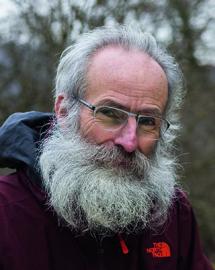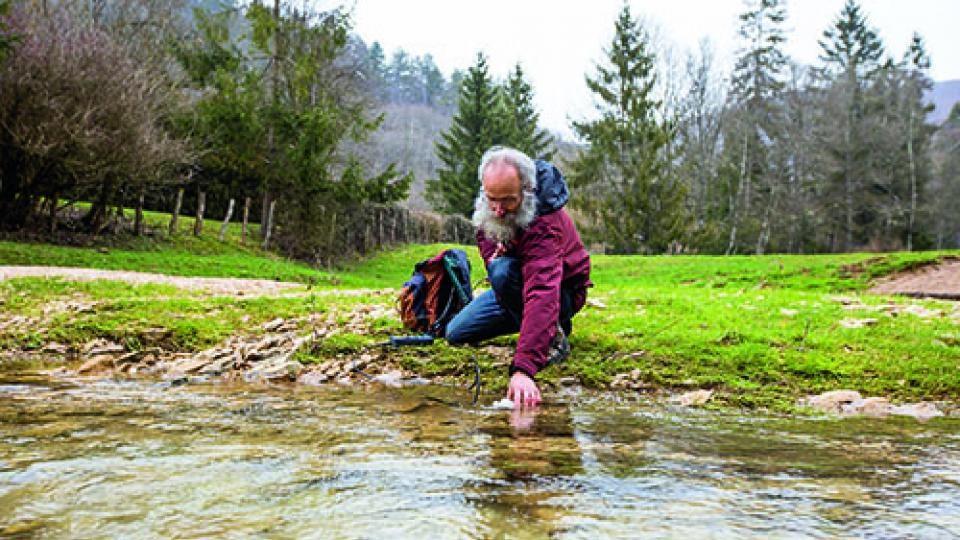Interview with... Emmanuel Soncourt, hydrogeologist
Hydrogeology is one of the components of Earth science. Little known, this complex discipline is concerned with the study of groundwater and how it is affected by human activity. Although it looks at many aspects of our daily life, it is above all indispensable for the reasoned management of the environment.
A specialist explains why.
What is hydrogeology?

Emmanuel Soncourt: Hydrogeology deals with all questions related to groundwater: the water underground and, more widely, natural water, from the moment it hits the ground to the moment that it reaches a river. Hydrogeologists are involved whenever human activity interferes with this water, whether to preserve water resources – both qualitatively and quantitatively – or to make better use of this resource. It’s a profession that people know very little about, but when you get up in the morning, wherever you live, you use services provided by hydrogeologists, if only to turn on the tap. A hydrogeologist must have been involved to locate the water abstraction point and to ensure that it is protected and continues to exist.
What are the responsibilities of a hydrogeologist?
E. S.: Their role concerns water production (drinking, industrial or irrigation water): drawing up hydrogeological syntheses to test for the presence of water, monitoring borehole works to identify the types of soil and the behaviour of different water tables, as well as analysing water quality or the ageing of water-intake structures. They also work on anything involving protecting water resources to ensure that human activity (agriculture, industry, transport, etc.) does not affect its quality. For existing or planned activities, their role consists in assessing and limiting the impact of the activity on groundwater.
How are hydrogeologists involved in activities like Andra’s?
E. S.: First of all, they are involved well upstream of the design of the proposed repository. Hydrogeologists are tasked with locating the most suitable waste management site and defining the measures to implement regarding construction to ensure that the repository meets regulatory requirements. The aim is to identify the optimal location to ensure that the facility remains secure, no matter what the circumstances. I participated in the preliminary studies for the construction of the Aube disposal facility from 1984 (ed. note: the facility opened in 1992). Some of the many studies carried out consisted in measuring the level of the water table at different points and in different seasons, analysing how it changes and extrapolating the results in unusual periods, known as ‘extreme high waters’. Throughout the operating period, using control measurements, the hydrogeologist will then verify the levels of the water table and quality of the water compared to reference measurements taken before the facility was built or upstream of the disposal facility.
“The hydrogeologist’s aim is to identify the optimal location to ensure that the facility remains secure, no matter what the circumstances.”
How can hydrogeology be used to anticipate potential risks?
E. S.: We always work from observed situations: the water levels measured in periods of low waters or high waters, for example. Then, we monitor the changes in these levels over periods of varying length. In Soulaines, the water sources have been monitored for over 30 years. Based on these observations, using complex mathematical calculations, we try to reconstitute extreme situations or events that have never been observed before. For example, based on a measurement from the water table in natural state, we can calculate the impact of pumping or a significant rise in the water level in different places on flow velocities, the path of water particles underground, etc. Today, interpretation methods and analytical calculation formulae make it possible to go very far with the simulation.

It is a complex science...
E. S.: Yes, it is a particularly complex discipline which brings all of the earth sciences into play since it looks at the interaction between the rock below the ground and the water particles that travel through it. The characteristics of the rock determine the behaviour of the groundwater. Hydrogeology is also to a great extent based on notions from physics, chemistry and mathematics. A hydrogeological survey sometimes resembles a scientific investigation: we collect evidence which we will use to develop hypotheses that we try to verify based on observations or additional calculations.
“A hydrogeological survey sometimes resembles a scientific investigation.”
Is preserving the environment the aim of hydrogeologists?
E. S.: Yes, of course, this is a very important aspect of our profession. But this notion of preservation is compounded by the environmental management dimension. It is not about preserving the environment as a museum collection; from the moment we are born into the world, we necessarily interact with it. The question is what can we tolerate, what interaction can we accept? There are two types of interaction. One that I will call ‘mining’: we draw on a resource excessively with regard to the resource’s ability to renew itself – and, in doing so, deprive our descendants of that resource, which is, in my opinion, impermissible – and another interaction which consists in a reasoned use of the environment: we use the renewable part of the resource without touching the capital.
Short bio
Emmanuel Soncourt has been a hydrogeologist for 40 years. Based in Côte-d’Or, he spent a large part of his career in the French Geological and Mining Research Bureau (BRGM), then in the engineering consultancy Antea in Reims and Dijon, before practising as a freelance hydrogeologist. He is specialised in water resource surveys, the management of surface and groundwater, and regulatory documentation according to the law on water and the French Public Health Code. From 1984 to 1989, he participated in the preliminary studies conducted on the sites chosen for the location of the Aube disposal facility.

